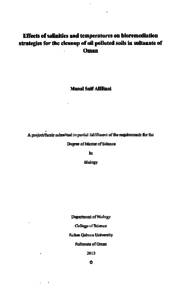وثيقة
Effects of salinities and temperatures on bioremediation strategies for the cleanup of oil polluted soils in Sultanate of Oman.
الناشر
Sultan Qaboos University
ميلادي
2013
اللغة
الأنجليزية
الموضوع
الملخص الإنجليزي
A desert soil and marine sediment, both contaminated with oil were subjected to different bioremediation approaches at different salinities and temperatures. The two samples were collected from two different geographical locations (Fahud and Main Al-Fahal) and their physical and chemical characteristics were compared. The samples pH was nearly alkaline which was optimum for oil degradation,Electron conductivity as well as nutrient availability and the abundance of microbes were also determined to help us to understand the different bioremediation approaches. The desert soil was clay in texture yet the marine sediment was sandy. Two bioremediation approaches; biostimulation by the addition of limiting nutrients (NH4CL and NaH2PO4) and bioaugmentation involving the addition of bacterial consortium, were applied to the contaminated samples. The samples were tested at different salinity (2%, 4% and 7%) and temperatures (10, 30 & 50 °C). Oil degradation was followed by monitoring the evolution of CO2 using GC in closed glass bottles. The degree of oil mineralization was calculated from the evolved CO2. Total petroleum hydrocarbon (TPH) was also determined at the end of the experiment to verify the results obtained by CO2 evolution.
The desert samples showed high percentage of CO2 evolution as well as oil mineralization at different salinities and temperatures. There were an inverse relationship between the salinity and degradation. Yet, the increase in temperature resulted in an increase in oil degradation. The desert soil showed the best CO2 production and oil mineralization at 2% salinity and 50°C. However, the marine sediment showed no significant differences in CO2 evolution and oil mineralization at the different salinities whereas the maximum CO2 evolution at different temperatures was observed at 30°C. The biostimulation and bioaugmentation were found to enhance oil degradation in the two samples and adding both stimulants increased the degradation even more.The desert soil at 7% salinity, displayed 2.1% of CO2 production in the untreated soil yet adding both stimulants increased the production to 3.5%.TPH analysis suggested that oil degradation was occurring in the untreated samplesmost likely with the help of indigenous oil-degrading bacteria, a process known as natural attenuation. The degradation of TPH decreased from 17.2 ppm in the untreated desert soil to 6.9-7.8 ppm in the three different treated soils at 50 °C.We conclude that the polluted sites are usually heterogeneous in their nature and affected by different environmental parameters and thus the data obtained from one site are not necessarily applicable in another site.
المجموعة
URL المصدر
الملخص العربي
عينات من تربة صحراوية ورواسب بحرية ملوثة بالنفط الخام تم تعريضها إلى معالجات بيولوجية مختلفة في درجات حرارة وملوحة متباينة. كلا العينتين تم تجميعهم من مناطق مختلفة (فهود وميناء الفحل) ومن ثم مقارنة خواصهم الكيميائية والفيزيائية. منهجان تم تطبيقهم على العينات الملوثة الأول كان بإضافة المواد المغذية نیترات و فوسفات) والثاني بإضافة مجموعة من البكتريا. بعد ذلك تم مراقبة تحلل المواد البترولية عن طريق ثاني أكسيد الكربون الناتج باستخدام (Gas Chromatography). كما تم تحديد إجمالي الكربوهيدرات النفطية للعينات قبل وبعد المعالجة.
أظهرت عينات الصحراء نسبة مرتفعة لثاني أكسيد الكربون وتحلل تام في درجات الحرارة والملوحة المختلفة. فقد تم ملاحظة وجود علاقة عكسية بين الملوحة والتحلل البترولي أما زيادة درجة الحرارة فأدت الى زيادة التحلل البترولي. بينما أظهرت الرواسب البحرية بأنه لا يوجد اختلاف في كمية ثاني أكسيد الكربون الناتج والتحلل البترولي باختلاف درجة الحرارة. لكن كانت أقصى كمية ناتجة من ثاني أكسيد الكربون عند درجة حرارة 30 درجة سيليزية. في حين لوحظ من نتائج تحليل إجمالي الكربوهيدرات البترولية في العينة الغير معالجة بيولوجيا بأن البكتريا الأصلية قامت بتحليل المواد البترولية حيث تعرف هذه العملية بالتوهين الطبيعي. وقد أدى كل من المنهجين إلى تعزيز تحلل المواد البترولية في كلا العينتين. إضافة إلى ذلك وجد بأن كل من المعززات عند تواجدهم معا تعمل على زيادة عملية التحلل البترولي بشكل أكبر. نستنتج من ذلك بسبب تباين الظروف البيئية للمواقع الملوثة يتوجب قيام دراسات مستقلة فليس بالضرورة بان البيانات التي تم الحصول عليها من موقع واحد تنطبق على موقع آخر.
أظهرت عينات الصحراء نسبة مرتفعة لثاني أكسيد الكربون وتحلل تام في درجات الحرارة والملوحة المختلفة. فقد تم ملاحظة وجود علاقة عكسية بين الملوحة والتحلل البترولي أما زيادة درجة الحرارة فأدت الى زيادة التحلل البترولي. بينما أظهرت الرواسب البحرية بأنه لا يوجد اختلاف في كمية ثاني أكسيد الكربون الناتج والتحلل البترولي باختلاف درجة الحرارة. لكن كانت أقصى كمية ناتجة من ثاني أكسيد الكربون عند درجة حرارة 30 درجة سيليزية. في حين لوحظ من نتائج تحليل إجمالي الكربوهيدرات البترولية في العينة الغير معالجة بيولوجيا بأن البكتريا الأصلية قامت بتحليل المواد البترولية حيث تعرف هذه العملية بالتوهين الطبيعي. وقد أدى كل من المنهجين إلى تعزيز تحلل المواد البترولية في كلا العينتين. إضافة إلى ذلك وجد بأن كل من المعززات عند تواجدهم معا تعمل على زيادة عملية التحلل البترولي بشكل أكبر. نستنتج من ذلك بسبب تباين الظروف البيئية للمواقع الملوثة يتوجب قيام دراسات مستقلة فليس بالضرورة بان البيانات التي تم الحصول عليها من موقع واحد تنطبق على موقع آخر.
قالب العنصر
الرسائل والأطروحات الجامعية

